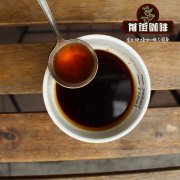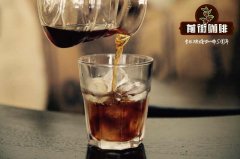What are blended coffee beans? Can Italian beans be made by hand? Italian coffee beans can be made by themselves.

Professional coffee knowledge exchange More coffee bean information Please pay attention to coffee workshop (Weixin Official Accounts cafe_style)
What is coffee blend? Can Italian-style mixed beans be washed by hand? Can Italian coffee beans be mixed by themselves?
Blending: Due to the different nature of coffee beans and different tastes, most coffee shops do not simply use a single variety and source of coffee beans to brew coffee, but mix several different kinds and taste characteristics of coffee beans with different roasting depths to become blended beans, which is what everyone calls "Blend beans". Because people in different regions have different requirements for the taste of coffee, the flavor of beans mixed by each coffee shop will be very different, but everyone will balance the various flavors and thickness as the ultimate goal, so that their own beans can be accepted by the public. Most of the Italian milk foam coffee series often drunk in coffee shops is brewed with blended beans, while a few coffee shops will also serve coffee brewed with a single variety of coffee beans, usually served in a sugar-free and milk-free manner. According to the characteristics of each coffee bean and roasting degree and proportion, blend into different flavors of coffee blend to increase the taste, aroma and complexity.
The full name of single origin coffee refers to a single variety of coffee beans from the same region and the same estate. Coffee beans from each region have different characteristics, and "single drink" is to taste coffee brewed from a single estate coffee bean, usually in the form of black coffee without sugar and milk, to taste the unique taste of that variety of coffee beans.
In the traditional commercial world, coffee beans from different origins are blended to achieve balanced taste and uniform taste, and to reduce costs. When the boutique coffee shops represented by the third wave began to notice that the shelf life of green coffee beans was not as long as previously recognized (1- 2 years), they put forward stricter requirements, and the concept of seasonal blending was born. Since coffee ripening and harvesting seasons are different in coffee producing countries around the world, fresh coffee beans from different origins can be purchased all year round. Mix the best coffee beans you can get in the season and create a recipe suitable for espresso. The result is that customers may go to the store to drink coffee with subtle differences in taste between seasons. For example, in summer you can drink an espresso with strawberry and pineapple aromas, and in winter it may be rubber muffin or toffee flavor. Coffee is a product of nature and cannot remain unchanged like industrial products. To be able to drink coffee with such colorful flavors should be the charm of coffee
To make coffee blends, even seasonal blends (usually about 3 months, coffee shops will change the blend once) are difficult to avoid to the late blend of aroma and taste is not as good as when the blend was first launched. This is because the overall quality of coffee beans will decline with preservation, but different coffee beans, this quality decline rate is not the same.
Dry fragrance: coffee beans after grinding the aroma, in general, there will be nut fragrance, oil fragrance, fruit fragrance, burnt fragrance, floral aroma, etc., and the intensity is affected by the degree of roasting.
Wet aroma: coffee after brewing after the distribution of aroma, category and dry aroma similar, but with hot water gas, the same coffee beans by the distribution of aroma types and intensity will greatly change. It can be imagined that dry incense is generally oil-soluble, while wet incense tends to be water-soluble.
Flavor: Each estate's individual coffee varieties will have their own unique flavor. It is usually dominated by fruit, flower and nutty flavors, which are also subdivided into different fruit types, such as citrus, berry, plum, rose, jasmine, kernel, cocoa and so on. Each single-serve coffee will have several to dozens of different flavors that blend into the unique flavor of the variety. These different flavors will have different performances under different brewing methods and extraction temperatures. Generally speaking, the sweet and bitter flavors will appear first at high temperatures, and when the temperature decreases, the sweet and sour flavors will slowly emerge. The complexity of flavor is how many flavors a bean can rush out under the same brewing method. The more flavors it has, the more complex the flavor of coffee.
Fruit acid: It can be said that it is a kind of flavor, but the position of fruit acid is more important in various flavors. These fruit acids and coffee generally drink in the tea restaurant sour completely different, tea restaurant coffee because of excessive extraction, that is, we call "pot left" and sour, is with a pungent sour; and high-grade coffee beans acid is a unique aroma of sour, coupled with the flavor of coffee itself, will become very delicious and aromatic fruit acid sweet feeling. All single-serving coffee beans will have varying degrees of fruit acid, and the differences can be very large, ranging from almost indistinguishable to a distinctive fruit acid as the main character. The performance of fruit acids varies with the processing method of fresh beans (sunlight? Washing?) The barista can also control the acidity of the coffee by controlling the extraction temperature.
Thickness: Chen Hao's program often said body, but also Su Si Huang said very annoying taste. Just as a sommelier uses his tongue to measure the weight of wine when testing red wine, so a coffee cup tester uses it to measure the thickness of coffee. The thickness is affected by the crema and roasting of the coffee beans themselves, and different brewing methods also affect the thickness.
Clear: This is a more abstract concept. Some of the beans have a strong flavor character, distinct layers, and jump off like a piece of paper, and we say that coffee has a distinct flavor. On the other hand, if some of the coffee's flavors are softer and heavier, without a special sense of dominance, we will say that it has a soft, deep flavor.
Aftertaste: that is, red wine lovers say after taste, when the coffee slides into the throat, there is a part of the taste will stay on the tip of the tongue for a long time, this is aftertaste. Compared with the overall flavor of coffee, the taste of aftertaste is relatively simple, but the feeling time is extremely long, bringing no less shock than the overall flavor.
Mixed taste: Mixed taste refers to wild taste such as burnt taste, charcoal taste, earthy taste, bitter taste, herbal taste, etc. These flavors are usually produced by improper roasting or over-extraction, and some are inherent in the coffee beans themselves. Sometimes a small amount of off-flavor can be unique to the coffee bean, and the barista will use different brewing techniques to try to reduce the undesirable off-flavor of the bean itself, or to try to reconcile the off-flavor and flavor.
Cupping test: The way a barista tests beans. There are many different coffee bean competitions in the world, which score hundreds of coffee beans from all over the world. The cup test is used. Generally, the beans are lightly roasted, ground, and directly hit with hot water. After the flour precipitates, the residue on the surface is removed, and then the coffee is tested with a teaspoon to score the overall flavor of the beans. Usually, a bean is tested five times. Baristas believe that this will extract coffee's original flavor, including impurities. Just like a Wine Master, becoming a Cup Tester requires a series of licensing tests. However, it should be noted that, unlike wine tasting, the purpose of cup testing is not to taste coffee, but to measure the performance and stability of coffee beans through repeated testing and make a score, which is an important threshold to maintain the quality of fine coffee. The Cup of Excellence (CoE) is published annually by the World Fine Baristas Association, which selects the top ten coffee beans with the best flavor stability from hundreds of coffee beans.
Front Street Recommended Brewing:
Filter cup: Hario V60
Water temperature: 88 degrees
Polishing degree: Small Fuji Polishing degree 4
Cooking method: water-powder ratio 1:15, 15g powder, first injection of 25g water, stewing for 25s, second injection to 120g water, water cut off, wait for the powder bed water to drop to half, then inject water slowly until 225g water, extraction time about 2:00
Analysis: Three-stage brewing, clear coffee before, during and after the flavor. Because V60 has many ribs, the drainage speed is faster, and the extraction time can be prolonged when the water is cut off.
Important Notice :
前街咖啡 FrontStreet Coffee has moved to new addredd:
FrontStreet Coffee Address: 315,Donghua East Road,GuangZhou
Tel:020 38364473
- Prev

How about traditional Italian coffee blends? Is it okay to mix coffee beans for hand brewing?
Professional coffee knowledge exchange More coffee bean information Please pay attention to coffee workshop (Weixin Official Accounts cafe_style) How about traditional Italian coffee formula? Is it okay to make espresso beans by hand? Coffee blending refers to mixing two or more different varieties of coffee or the same variety of coffee but different degrees of roasting coffee according to a certain proportion. mixed
- Next

Is mamba coffee good coffee? Introduction to mamba coffee? What's the flavor and taste of Mamba coffee?
Professional coffee knowledge exchange more coffee bean information please follow the coffee workshop (Wechat official account cafe_style) Mamba coffee is a good coffee? Introduction to mamba coffee? What's the flavor and taste of mamba coffee? Mamba coffee is defined as Indonesian manning coffee + Brazilian coffee. The taste of mamba coffee: if you are used to drinking deep-roasted coffee from traditional cafes, you will know.
Related
- Detailed explanation of Jadeite planting Land in Panamanian Jadeite Manor introduction to the grading system of Jadeite competitive bidding, Red bid, Green bid and Rose Summer
- Story of Coffee planting in Brenka region of Costa Rica Stonehenge Manor anaerobic heavy honey treatment of flavor mouth
- What's on the barrel of Blue Mountain Coffee beans?
- Can American coffee also pull flowers? How to use hot American style to pull out a good-looking pattern?
- Can you make a cold extract with coffee beans? What is the right proportion for cold-extracted coffee formula?
- Indonesian PWN Gold Mandrine Coffee Origin Features Flavor How to Chong? Mandolin coffee is American.
- A brief introduction to the flavor characteristics of Brazilian yellow bourbon coffee beans
- What is the effect of different water quality on the flavor of cold-extracted coffee? What kind of water is best for brewing coffee?
- Why do you think of Rose Summer whenever you mention Panamanian coffee?
- Introduction to the characteristics of authentic blue mountain coffee bean producing areas? What is the CIB Coffee Authority in Jamaica?

